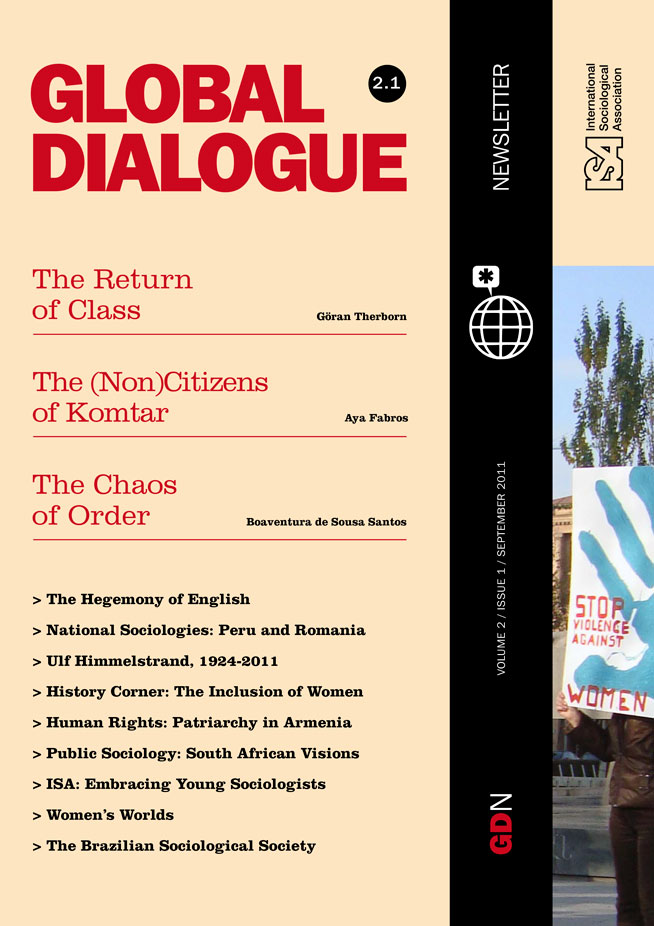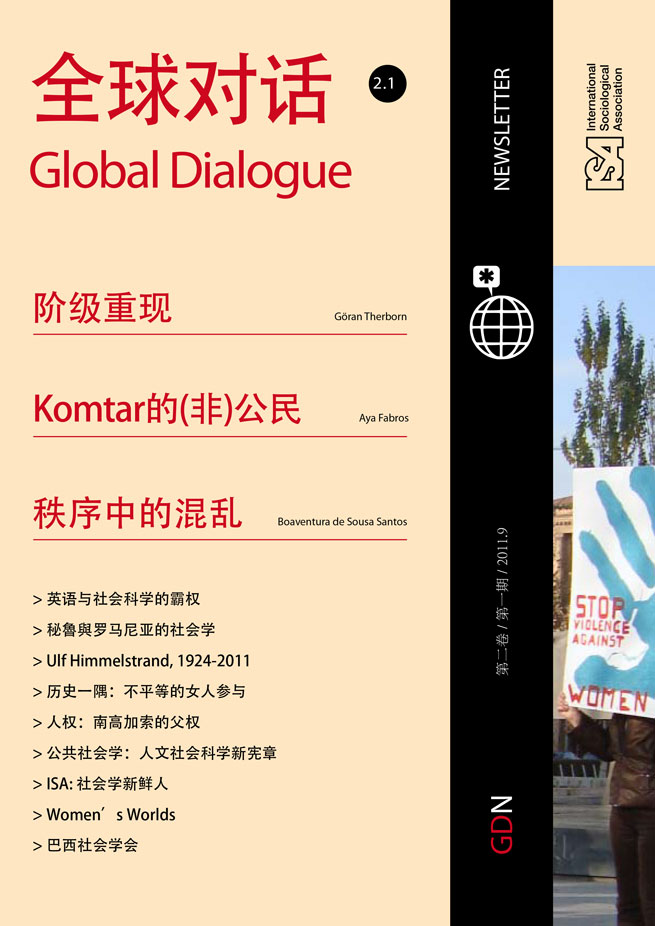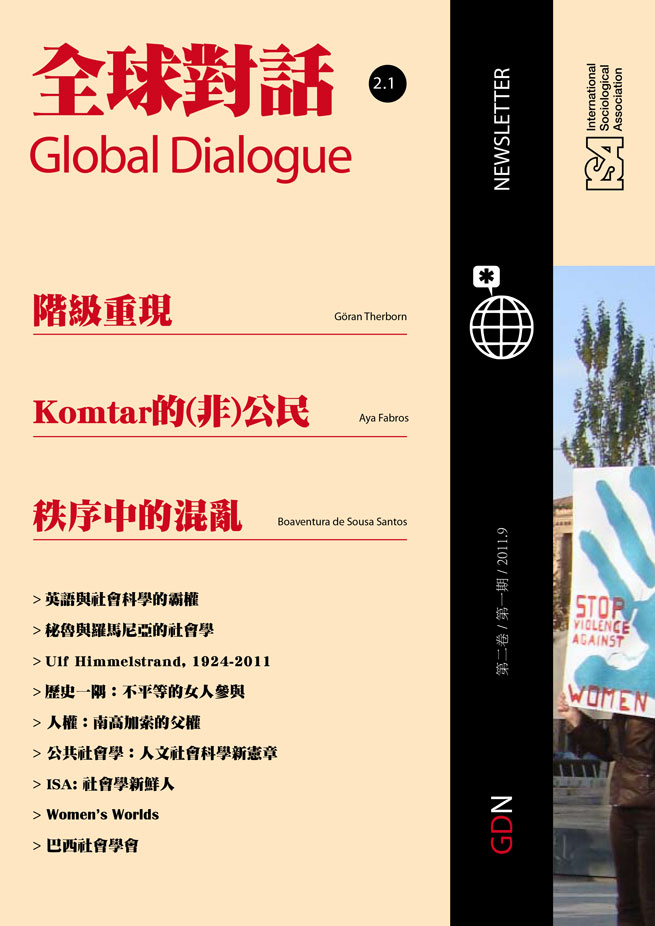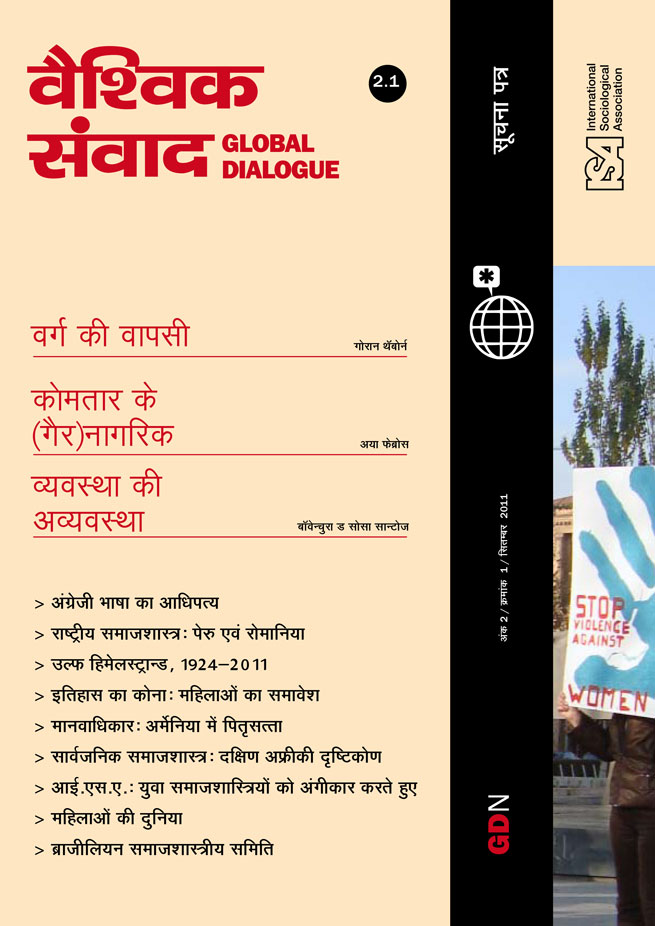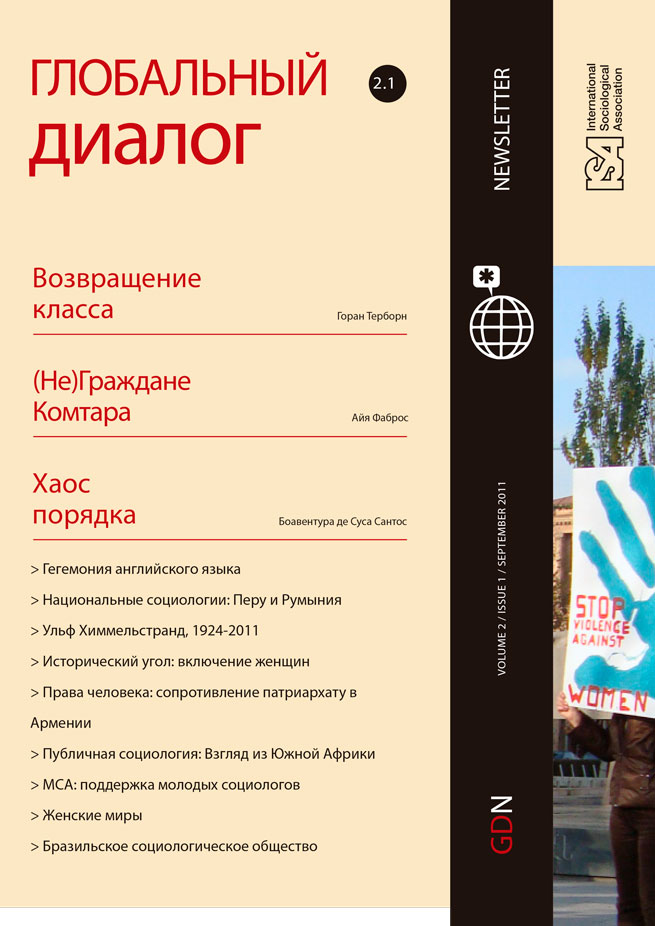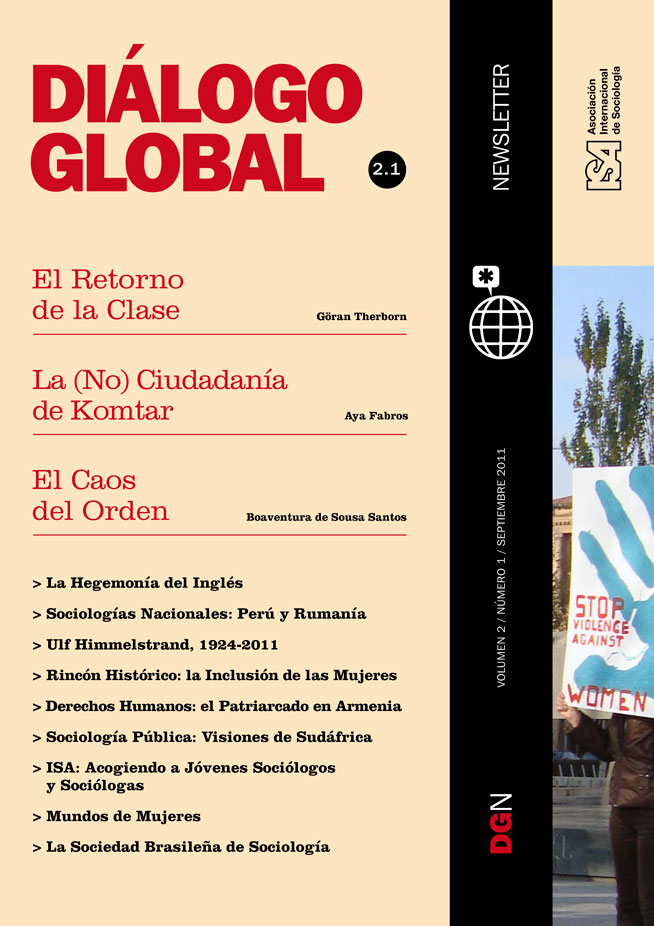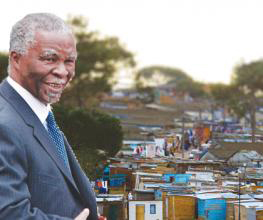Read more about Inequality and Protest
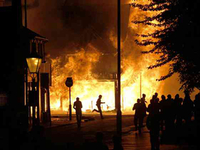
The Chaos of Order
by Boaventura de Sousa Santos
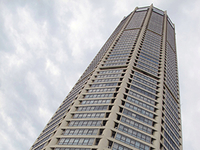
The (Non)Citizens of Komtar: Transnational Migrants Forging Their Own Communities in Malaysia
by Aya Fabros
September 30, 2011
The last two decades have been good for poor nations of the world. Since the late 1980s, what the international economic organizations call “developing Asia”, mainly China, India and the ASEAN countries, has been growing at a pace about double the world as a whole. Since 2001, sub-Saharan Africa, the tragic laggard of development in the last third of the last century, has been outgrowing the world, including the ‘advanced economies’. Latin America has been growing faster than the rich world since 2003, and the Middle East since 2000. Except for post-Communist Europe, ‘emerging and developing economies’ also weathered the Anglo-Saxon bankers’ crisis much better than the rich world.
Nations and Classes
We are experiencing a historical turn, not only in geopolitics but also in terms of inequality. The 19th and 20th century international development of underdevelopment meant, among other things, that inequality among humans became increasingly shaped by where they lived, in developed or underdeveloped areas, territories, nations. By 2000, it has been estimated that 80 per cent of the income inequality among households depended on the country you live in (Milanovic 2011: 112). This is currently changing. Inter-national inequality is declining overall, although the gap between the rich and the poorest has not stopped growing. But intra-national inequality is, on the whole, increasing, albeit unevenly, denying any pseudo-universal determinism of ‘globalization’ or of technological change.
This amounts to a return of class, as an increasingly powerful global determinant of inequality. Class has always been important, but in the 20th century context of mainly national class organizations and class struggles – albeit including some networks of ‘proletarian internationalism’ – national class inequality was overshadowed by global inter-national gaps. Now, nations are growing closer, and classes are growing apart.
The class side of the new global distribution pattern grew to prominence in the 1990s. That was the time when Chinese inequality soared, even more than along the capitalist road in the former Soviet Union, when the modest tendency to (rural) equalization in India was reversed into increasing rural as well as urban inequality. In Latin America, Mexico and Argentina had their neoliberal inequality shocks. An IMF (2007: 37) study has shown, if not properly reflected upon, that on a global scale the only group which increased its income share in the 1990s was the richest national quintile, in high as well as in low income countries. All the other quintiles were losers, although not dramatically.
The most important changes have taken place at the very top of the income distribution, between the richest 1%and the rest – and between the 0.1% or 0.01% and the rest. The US Nobel economist Joseph Stiglitz has recently (Vanity Fair, May 2011) pointed to the capture of his country by the richest one per cent, who own 40% of the nation’s wealth, who appropriate nearly a quarter of the annual national income, and who make up virtually the whole US Congress. Around the turn of the last century the richest 1% accounted for 15% of US income, as against 9-11% in India (Banerjee and Piketty, 2003).
The inegalitarian trends of China and India, and of developing Asia generally, have continued in the new millennium, as in USA (Luo and Zhu 2008; Kochanowicz et al. 2008; Datt and Ravaillon 2009). Accelerated economic growth in India, for instance, has hardly had any positive effect on the poorest fifth of Indian children, two thirds of whom were underweight – a life-long weakening condition – in 2009, as in 1995 (UN 2011: 14). The vigorous economic growth in the 2000s of what used to be the Third World has had no effect on hunger in the world. The number of undernourished has risen from 618 to 637 million people, 16% of humankind between 2000 and 2007 (UN 2011: 11). Food prices continue to rise. At the other end, in March 2011 Forbes magazine gleefully announced two records of its listed billionaires in 2010, namely, their record number, 1,210, and their total wealth, $4.5 trillion, larger than the GDP of the world’s third largest national economy, Germany. 413 are Americans, 115 (mainland) are Chinese, and 101 are Russians.
However, there is no inevitability, technical or economic, about increasing inequality. From its admittedly vulnerable position as the world’s economically most unequal region, Latin America is currently the only region of the planet where inequality is decreasing (CEPAL 2010; UNDP 2010). As this is largely a political effect (Cornia and Marorano 2010), of revulsion against the neoliberalism of the military dictators of the 1970s and 1980s, and of their more or less democratically elected civilian successors, the ongoing redistribution policies of Argentina, Brazil, Venezuela and others also reflect the importance of class, in this case the money-grabbing of the rich oligarchs.
Another way of comparing (income) classes across nations is to calculate their Human Development Index, which includes income, life expectancy, and education, a heroic, very complicated operation with considerable margins of error. Nevertheless, it offers a noteworthy picture of world inequality. The poorest American quintile has a lower level of human development than, e.g., the richest quintile of Bolivia, Indonesia, and Nicaragua, below the most lucky 40% of Brazil and Peru, and has a level about equal to the fourth quintile of Colombia, Guatemala, and Paraguay. (Grimm et al. 2009, Table 1.)
Class, at least as a reference of distributive justice, is also likely to grow for other reasons than national economic convergence. Existential inequalities of racism and sexism, even if still potent here and there, are clearly being eroded. An important recent example is the fall of apartheid in South Africa. Democratic South Africa is also giving us one of the most dramatic examples of class inequality after institutionalized racism. Daring World Bank economists, Branko Milanovic (2008: Table 3) and others, have estimated the Gini coefficient of income inequality among the households of the planet at about 65-70 in the 1990s-2000s. But in 2005 the city of Johannesburg has one of 75! And this was measured in terms of consumer expenditure, which always gives a lower inequality figure than income measures (UN Habitat 2008: 72). Even allowing for margins of error, it does not seem presumptuous to say that the post-apartheid city of Johannesburg harbors at least as much economic inequality among its (mainly citizen) inhabitants as all the humans on the planet.
Four Roads of Class Politics
The likely resurgence of class may take at least two, very different directions, a middle-class and a working-class direction, each with two major sub-variants. One, ideologically predominant, middle-class variant looks forward to an emerging global middle class taking possession of the earth, buying cars, one-family houses, and an endless amount of electronics and consumer durables, and spending on international tourism. While this globalized and upgraded consumerism may cause nightmares for ecologically conscious people, it makes businessmen, the business press, and business institutions salivate. Middle-class consumerism has the great advantages, on top of business profits, of both accommodating the privileges of the rich and of providing a quiescent horizon of aspiration for the popular classes. These business dreams are not beyond the possible, but they tend to underestimate the social explosiveness of the current trajectory of economic distanciation and exclusion.
In the second alternative, the widening gap between the middle class and the rich carries the former into politics before consumption. In recent years we have seen something which Europeans, at least, have not experienced since 1848 – middle classes mobilizing in the streets, even making middle-class revolutions. Many of these middle-class mobilizations have been socially and economically reactionary, like those against Allende in Chile and against Chavez in Venezuela, or, more recently, the US Tea Party. Contrary to liberal mythology, there is nothing inherently democratic in middle-class mobilizations, the Thai “Yellow Shirts” of 2008, or the drivers of the putsches in Chile and Venezuela bear witness to that.
Other middle-class protests, however, have been hostile to oligarchic, ‘crony’ capitalism as well as oligarchic politics. The so-called Orange revolution in the Ukraine may come closest to the ideal type. But the ‘Arab Spring’ of 2011 also included a significant, probably crucial middle-class component. The exclusive capitalism of high finance or of high politics, the political economy of, by, and for the richest one per cent, might bring an angry middle class onto the political stage with unpredictable outcome.
The other class direction focuses on the working class. The era of a historically vanguard industrial capitalism has now gone, together with the opponent it empowered , namely, the working-class movement, predicted by Marx in mid-19th century, which did materialize in Europe, in the Nordic countries above all. Europe and North America are now de-industrializing, private financial capitalism is outgrowing public sectors, the working classes are being divided, defeated, and demoralized. The resulting economic polarization and soaring intra-nation inequality is the North Atlantic contribution to the global resurgence of class (as a structural mechanism of distribution).
The relay of an industrial working class has been passed on to China, the emerging centre of world manufacturing. Today’s Chinese industrial workers are largely immigrants in their own country, given the still lingering hukou system of different urban and rural birthrights. But the growth of Chinese industrial capitalism is strengthening the workers’ hand as currently manifested in localized protests and rising wages (Cf. Pun Ngai in Global Dialogue 1.5). The political regime of China is still formally committed to socialism, in some sense. What the future holds is anybody’s guess. But a new round of distributive conflict, driven by industrial labor, largely displaced from Europe to East Asia, is not to be excluded.
A fourth class scenario would derive its primary dynamic from the heterogeneous popular classes of Africa, Asia, Latin America, and their, perhaps, less forceful counterparts in the rich world. Empowered by a rise of literacy and by new means of communication, the popular class movements face great hurdles of division – ethnicity, religion, and particularly the divide between formal and informal employment – as well as the dispersion of activities, for example in street hawking and small sweatshops. But the barriers to organization, mobilization and rallying are not insurmountable. India has spawned strong organizations of self-employed, the Red Shirts movement of the Thai popular classes returned as the country’s prime political force in the July 2011 elections, and popular class coalitions have produced left-of-centre governments in Brazil and in a number of Latin American countries.
Each of these four class approaches to world inequality has a sociological plausibility, globalized middle-class consumerism, middle-class political rebelliousness, industrial class struggle – including the possibility of class compromises – decamped from Europe to China and East Asia, and, fourthly, heterogeneous popular class mobilizations, headed by Latin American and Southeast Asian movements, but possibly involving Arab countries and Sub-Saharan Africa (Cf. Enrique de la Garza and Edward Webster in Global Dialogue 1.5). The most likely scenario for the future are strides along all four roads. Their relative significance is not only impossible to predict, but weighing the evidence as well as assessing its meaning and value are also likely to be controversial.
More clear, however, is that while nation-states remain formidable organizations and class conflicts will remain mainly state-bounded, the new turn of global inequality means that classes will rise and nations decline in determining human life-courses.
References
Banerjee, A., and Piketty, T. 2003. “Top Indian Incomes, 1956-2000”, B R E A D working paper, http://ipl.econ.duke.edu/bread/papers.htm
CEPAL, 2010. La hora de la igualdad. Santiago de Chile, CEPAL.
Cornia, G.A., and Martorano, B. 2010. Policies for reducing income inequality: Latin America during the last decade. UNICEF Policy and Practice Working Paper. New York: UNICEF.
Datt, G., and Ravaillon, M. 2009. “Has India’s Economic Growth Become More Pro-Poor in the Wake of Economic Reforms?”, World Bank Policy Research Working Paper 5103, www.worldbank.org/
Grimm. M. et al. 2009. “Inequality in Human Development. An Empirical Assessment of 32 Countries”, Luxembourg Income Study, Working Paper 519, www.lisproject.org/publications/wpapers
IMF 2007. World Economic Outlook, October 2007. www.imf.org
Kochanowicz, J., et al. 2008. “Intra-Provincial Inequalities and Economic Growth in China”, Faculty of Economic Sciences, University of Warsaw, Working Paper no. 10/2008. www.wne.uw.edu.pl
Luo Xubei and Zhu Nong 2008. “Rising Income Inequality in China: A Race to the Top”, World Bank Policy Research Working Paper 4700. www.worldbank.org/
Milanovic, B. 2008. “Even Higher Global Inequality Than Previously Thought”, International Journal of Health Services: 48:2.
Milanovic, B. 2011. The Haves and the Have-Nots. New York, Basic Books.
UN 2011. The Millennium Development Goals Report 2011. www.un.org/
UNDP 2010. Regional Human Development Report for Latin America and the Caribbean. www.undp.org
UN Habitat 2008. The State of the World Cities 2008/9. www.unhabitat.org
Göran Therborn, University of Cambridge, UK, Linnaeus University, Sweden, and Member of the Program Committee for the ISA World Congress of Sociology in Yokohama
This issue is not available yet in this language.
Request to be notified when the issue is available in your language.
If you prefer, you can access previous issues available in your language:

